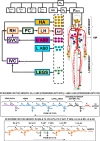Cardiovascular deconditioning during long-term spaceflight through multiscale modeling
- PMID: 33083524
- PMCID: PMC7529778
- DOI: 10.1038/s41526-020-00117-5
Cardiovascular deconditioning during long-term spaceflight through multiscale modeling
Abstract
Human spaceflight has been fascinating man for centuries, representing the intangible need to explore the unknown, challenge new frontiers, advance technology, and push scientific boundaries further. A key area of importance is cardiovascular deconditioning, that is, the collection of hemodynamic changes-from blood volume shift and reduction to altered cardiac function-induced by sustained presence in microgravity. A thorough grasp of the 0G adjustment point per se is important from a physiological viewpoint and fundamental for astronauts' safety and physical capability on long spaceflights. However, hemodynamic details of cardiovascular deconditioning are incomplete, inconsistent, and poorly measured to date; thus a computational approach can be quite valuable. We present a validated 1D-0D multiscale model to study the cardiovascular response to long-term 0G spaceflight in comparison to the 1G supine reference condition. Cardiac work, oxygen consumption, and contractility indexes, as well as central mean and pulse pressures were reduced, augmenting the cardiac deconditioning scenario. Exercise tolerance of a spaceflight traveler was found to be comparable to an untrained person with a sedentary lifestyle. At the capillary-venous level significant waveform alterations were observed which can modify the regular perfusion and average nutrient supply at the cellular level. The present study suggests special attention should be paid to future long spaceflights which demand prompt physical capacity at the time of restoration of partial gravity (e.g., Moon/Mars landing). Since spaceflight deconditioning has features similar to accelerated aging understanding deconditioning mechanisms in microgravity are also relevant to the understanding of aging physiology on the Earth.
Keywords: Biomedical engineering; Medical research.
© The Author(s) 2020.
Conflict of interest statement
Competing interestsThe authors declare no competing interests.
Figures





Similar articles
-
Falls and Fall-Prevention in Older Persons: Geriatrics Meets Spaceflight!Front Physiol. 2017 Oct 11;8:603. doi: 10.3389/fphys.2017.00603. eCollection 2017. Front Physiol. 2017. PMID: 29075195 Free PMC article. Review.
-
Altered Venous Function during Long-Duration Spaceflights.Front Physiol. 2017 Sep 12;8:694. doi: 10.3389/fphys.2017.00694. eCollection 2017. Front Physiol. 2017. PMID: 28955249 Free PMC article.
-
Computer systems analysis of spaceflight induced changes in left ventricular mass.Comput Biol Med. 2007 Mar;37(3):358-63. doi: 10.1016/j.compbiomed.2006.04.003. Epub 2006 Jun 30. Comput Biol Med. 2007. PMID: 16808910
-
Spacelab Life Sciences flight experiments: an integrated approach to the study of cardiovascular deconditioning and orthostatic hypotension.Acta Astronaut. 1987;15(5):291-4. doi: 10.1016/0094-5765(87)90074-9. Acta Astronaut. 1987. PMID: 11538833 Review.
-
Cardiovascular Response to Posture Changes: Multiscale Modeling and in vivo Validation During Head-Up Tilt.Front Physiol. 2022 Feb 17;13:826989. doi: 10.3389/fphys.2022.826989. eCollection 2022. Front Physiol. 2022. PMID: 35250630 Free PMC article.
Cited by
-
Bone marrow adiposity modulation after long duration spaceflight in astronauts.Nat Commun. 2023 Aug 9;14(1):4799. doi: 10.1038/s41467-023-40572-8. Nat Commun. 2023. PMID: 37558686 Free PMC article.
-
Sedative Agents, Synthetic Torpor, and Long-Haul Space Travel-A Systematic Review.Life (Basel). 2025 Apr 27;15(5):706. doi: 10.3390/life15050706. Life (Basel). 2025. PMID: 40430135 Free PMC article. Review.
-
Modelling large scale artery haemodynamics from the heart to the eye in response to simulated microgravity.NPJ Microgravity. 2024 Jan 13;10(1):7. doi: 10.1038/s41526-024-00348-w. NPJ Microgravity. 2024. PMID: 38218868 Free PMC article.
-
Relationship Between Baroreflex and Cerebral Autoregulation in Patients With Cerebral Vasospasm After Aneurysmal Subarachnoid Hemorrhage.Front Neurol. 2022 Jan 12;12:740338. doi: 10.3389/fneur.2021.740338. eCollection 2021. Front Neurol. 2022. PMID: 35095711 Free PMC article.
-
Spaceflight effects on human vascular smooth muscle cell phenotype and function.NPJ Microgravity. 2024 Mar 28;10(1):41. doi: 10.1038/s41526-024-00380-w. NPJ Microgravity. 2024. PMID: 38548798 Free PMC article.
References
-
- Buckey, J. C. Jr. Space Physiology. (Oxford University Press, 2006).
-
- Clément, G. Fundamentals of Space Medicine. (Springer, 2011).
-
- Arbeille P, et al. Adaptation of the left heart, cerebral and femoral arteries, and jugular and femoral veins during short- and long-term head-down tilt and spaceflight. Eur. J. Appl. Physiol. 2001;86:157–168. - PubMed
-
- Grigoriev AI, Kotovskaya AR, Fomina GA. The human cardiovascular system during space flight. Acta Astronaut. 2011;68:1495–1500.
LinkOut - more resources
Full Text Sources
Medical
Miscellaneous

